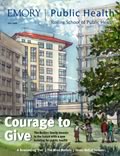The best kind of return

by Pam Auchmutey
A family invests in the lives of people
through the Claudia Nance Rollins Building
|
|
It was a day for honoring generations when ground was broken on a second RSPH building last spring. As members of the Rollins and Emory families gathered, they embodied the close-knit ties that have made the RSPH one of the nation's top 10 schools in its field.
"The word 'family' is widely used in the Rollins School of Public Health," said Emory President James Wagner. "It often refers to the incredible sense of community that exists in the school, among its leaders, faculty, students, alumni, and its public health partners. The word also refers to 'THE' family, a name increasingly recognized for its support of public health."
With the naming of the new building for Claudia Nance Rollins, the Rollinses' ties to Emory and the RSPH now span five generations. The building is named for the mother of O. Wayne and John Rollins, who were reared by Claudia and their father Henry in Catoosa County, Georgia. It was there that Claudia instilled in them a deep regard for family, community, and hard work. The two brothers became respected self-made businessmen through successful ventures from pest control to radio and television stations. Committed to improving the lives of those around them, they also became two of Emory's most distinguished benefactors.
As a university trustee, Wayne supported Emory's effort to establish a school of public health in 1990. Following his death in 1991, his family was instrumental in constructing the Grace Crum Rollins Building, named for his wife. In 1994, Emory named the school to honor the family's commitment to the university. The family subsequently funded the O. Wayne and Grace Crum Rollins Endowment for faculty research and the Center for Public Health Preparedness and Research.
Last year, the Rollins family stepped forward again to provide a $50 million lead gift through the O. Wayne Rollins Foundation for a second RSPH building to be connected to the Grace Crum Rollins Building by a glass corridor. The nine-story Claudia Nance Rollins Building will more than double the capacity of the RSPH complex and thus enhance its ability to improve health and prevent disease. Both buildings are a short distance from the O. Wayne Rollins Research Center in the School of Medicine.
"It's very fitting that my grandfather's research center will be next to a building named in honor of his mother, which in turn will be connected by a bridge to a building named for his wife," said Amy Rollins Kreisler, executive director of the O. Wayne Rollins Foundation. "These two women were very important figures in his life and had a close relationship with each other. It's very fitting that their buildings be connected."

Many members of the Rollins family attended the groundbreaking—Wayne and Grace's sons, Randall and Gary (Emory trustee emeritus and trustee, respectively), their wives Peggy and Ruthie, and many of Wayne and Grace's grandchildren and great-grandchildren. All are part of an extended family quilt that includes three generations of Emory leaders.
Fred Sanfilippo is among those leaders, having joined Emory last year as executive vice president for health affairs. Already, he has come to value the school's "unparalleled gift for collaboration and community. These partnerships and the school's role as a center for international health research and training contribute to Atlanta's reputation as the public health capital of the world," he said.
'A fortunate problem'
When James Curran became dean of the RSPH in 1995, the school had occupied the Grace Crum Rollins Building for nearly a year. The school has since tripled its students, faculty, and research. Now the school has what Kreisler calls "a fortunate problem"—the need for more space. The Claudia Nance Rollins Building will enable the school to expand its physical capacity, recruit additional faculty, grow its research and education programs, and attract more students with the goal of becoming one of the top five public health schools in the world.
"We cannot achieve those things without this building," said Curran. "And we would not have this building and all that it represents without the vision and generosity of the Rollins family."
Slated to open in fall 2010, the new facility will have technologically sophisticated "smart" classrooms, wet laboratories on three floors, offices, conference space, and an auditorium. It will support education and research in several key areas, including global health, predictive health, infectious disease, cancer, diabetes, and other chronic diseases. Conference capabilities will augment the development of training, distance-learning, and professional exchange programs. The Grace Crum Rollins Building will be renovated to enhance existing classroom and office space and provide a full-service cafe.
The building has been a partnership from the beginning. SLAM Collaborative, the building architect, has based its design on ideas generated by RSPH faculty, staff, students, and alumni; members of Emory's health sciences and university communities; and the Rollins family. Filled with natural light and energy-saving features, the building is designed to achieve silver status for Leadership in Energy and Environmental Design.
Once it opens, the Claudia Nance Rollins Building also will enable the school to better serve the university, city, state, nation, and world, just as its multiple planners intended.
"Many of our alumni think of themselves as Rollins graduates, and as those alumni practice what they learn here, hundreds of thousands of people throughout the city and the world know the Rollins name as a sign of hope," Curran told the great-great grandchildren of Claudia Nance Rollins at the groundbreaking. "Most of those people will never know you, but like us, they will be grateful to you."
As the ceremony concluded, Kreisler reflected on what the new building and the RSPH would mean to O. Wayne Rollins.
"My grandfather once said that 'giving to a living institution that goes on and on and affects people's lives—to me that's the best. That's the highest kind of giving when you invest in people.' I can't think of a better example of his philosophy than this school."



